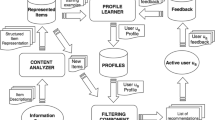Abstract
IR (Information Retrieval) systems search for important documents on the internet by measuring the importance of them. For this purpose, various ranking techniques were proposed. In this paper, we propose ReviewRank and ReviewRank+, which are ranking techniques for estimating usefulness of book reviews based on the tendency of users. With an increasing number of people buying books online, reviews written by other people have become more significant. General ranking techniques measure the importance of documents based on references or quotations between them through hyperlinks. However, the techniques are not suitable for ranking book reviews since they were developed for general purposes. In this paper, we analyze the characteristics of meaningful book reviews based on voluntary evaluation of people and propose measures for considering the importance. We also suggest an algorithm for ranking reviews. Experimental results show that our approaches outperform both previous general and specific (searching book reviews) ranking techniques.












Similar content being viewed by others
References
Aboulmagd H, El-Gayer N, Onsi H (2009) A new approach in content-based image retrieval using fuzzy. TELSYS 40(1–2):55–66
Aizawa AN (2003) An Information-theoretic perspective of Tf-idf measures. Inf Process Manag 39(1):45–65
Alyguliev RM (2007) Analysis of hyperlinks and the ant algorithm for calculating the ranks of web pages. ACCS 41(1): 44–53
Brin S, Page L (1998) The Anatomy of a Large-scale Hypertextual web search engine. WWW 30(1–7):107–117
Chang Y, Dong A, Kolari P, Zhang R, Inagaki Y, Diaz F, Zha H, Liu Y (2013) Improving recency ranking using twitter data. ACM TIST 4(1)
Ciszkowski T, Mazurczyk W, Kotulski Z, Hobfeld T, Fiedler M, Collange D (2012) Towards quality of experience-based reputation models for future web service provisioning. TELSYS 51(4):283–295
Curran K, Baumgarten M, Mulvenna M, Nugent C, Greer K (2009) A computational intelligence method for traversing dynamically constructed networks of knowledge. TELSYS 40(1–2):27–37
Dou Z, Song R, Nie JY. Wen JR (2009) Using anchor texts with their hyperlink structure for web search. SIGIR:227–234
Duan Y, Jiang L, Qin T, Zhou M. Shum HY (2010) An Empirical Study on Learning to Rank of Tweets. COLING:295–303
Egghe L, Leydesdorff L (2009) The relation between pearson’s correlation coefficient r and Salton’s cosine measure. CoRR
Gayo-Avello D (2010) Nepotistic relationships in twitter and their impact on rank prestige algorithms. CoRR
Gupta P, Singh K, Yadav D, Sharma K (2013) An improved approach to ranking web documents. JIPS 9(2):217–236
Huang JJS, Yang SJH, Chen JYL, Li I, Hsiao IYT (2010) A social book-marking-based people search service building communities of practice with collective intelligence. IJOCI 1(2):83–95
Janik M, Scherp A, Staab S (2011) The semantic web: collective intelligence on the web. INSK 34(5):469–483
Jarvelin K, Kekalainen J (2000) IR evaluation methods for retrieving highly relevant documents. SIGIR:41–48
Kleinberg JM (1999) Authoritative sources in hyperlinked environment. JACM 46(5):604–632
Krol D, Lopes HS (2012) Nature-inspired collective intelligence in theory and practice. Inf Sci 182(1)
Lee G, Yun U, Ryu K (2014) Sliding window based weighted maximal frequent pattern mining over data streams. Expert Syst Appl 41(2):694–708
Leimeister JM (2010) Collective intelligence. BISE 2(4):245–248
Momma M, Chi Y, Lin Y, Zhu S, Yang T (2012) Influence analysis in the blogosphere. CoRR
Page L, Brin S, Motwani R, Winograd T (1999) The pagerank citation ranking: bringing order to the web. Technical report, Stanford InfoLab
Paik J (2013) A novel TF-IDF weighting scheme for effective ranking. SIGIR:343–352
Pioro M, Rak J, Szczypiorski K (2013) Networks for the e-society. TELSYS 52(2):931–933
Pyun G, Yun U, Ryu K (2014) Efficient frequent pattern mining based on linear prefix tree. Knowl-Based Syst 55:125–139
Ryang H, Yun U (2011) effective ranking techniques for book review retrieval based on the structural feature. Lecture note in computer science, ICHIT:360–367
Ryang H, Yun U (2012) Book review retrieval techniques for adopting estimated reviewer quality. Lecture note in computer science, ICHIT:550–557
Ryang H, Yun U (2013) Ranking book reviews based on user discussion. lecture notes in electrical engineering, MUSIC:7–11
Teevan J, Ramage D, Morris MR (2011) #TwitterSearch: a comparison of microblog search and web search. WSDM:35–44
Tumer D, Wolpert D (2011) Collective intelligence, data routing and Braess’ paradox. CoRR
Weerkamp W, Rijke M (2012) Credibility-inspired ranking for blog post retrieval IR 15(3–4):243–277
Wu S (2012) Applying the data fusion technique to blog opinion retrieval. ESWA 39(1):1346–1353
Yun U, Lee G, Ryu K (2014) Mining maximal frequent patterns by considering weight conditions over data streams. Knowl-Based Syst 55:49–65
Yun U, Ryang H, Ryu K (2014) High utility itemset mining with techniques for reducing overestimated utilities and pruning candidates. Expert Syst Appl 41(8):3861–3878
Yun U, Ryu K (2013) Efficient mining of maximal correlated weight frequent patterns. Intell Data Anal 17(5):917–939
Zhou L (2013) Green service over internet of things: a theoretical analysis paradigm. TELSYS 52(2):1235–1246
Acknowledgments
This research was supported by the National Research Foundation of Korea (NRF) funded by the Ministry of Education, Science and Technology (NRF No. 2013–005682 and 2008–0062611).
Author information
Authors and Affiliations
Corresponding author
Rights and permissions
About this article
Cite this article
Ryang, H., Yun, U., Pyun, G. et al. Ranking algorithm for book reviews with user tendency and collective intelligence. Multimed Tools Appl 74, 6209–6227 (2015). https://doi.org/10.1007/s11042-014-2101-4
Received:
Accepted:
Published:
Issue Date:
DOI: https://doi.org/10.1007/s11042-014-2101-4




